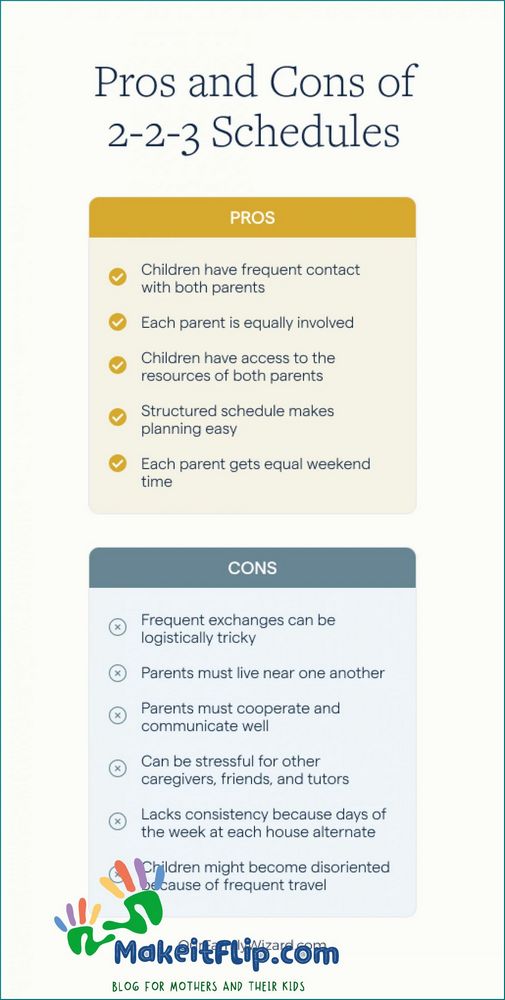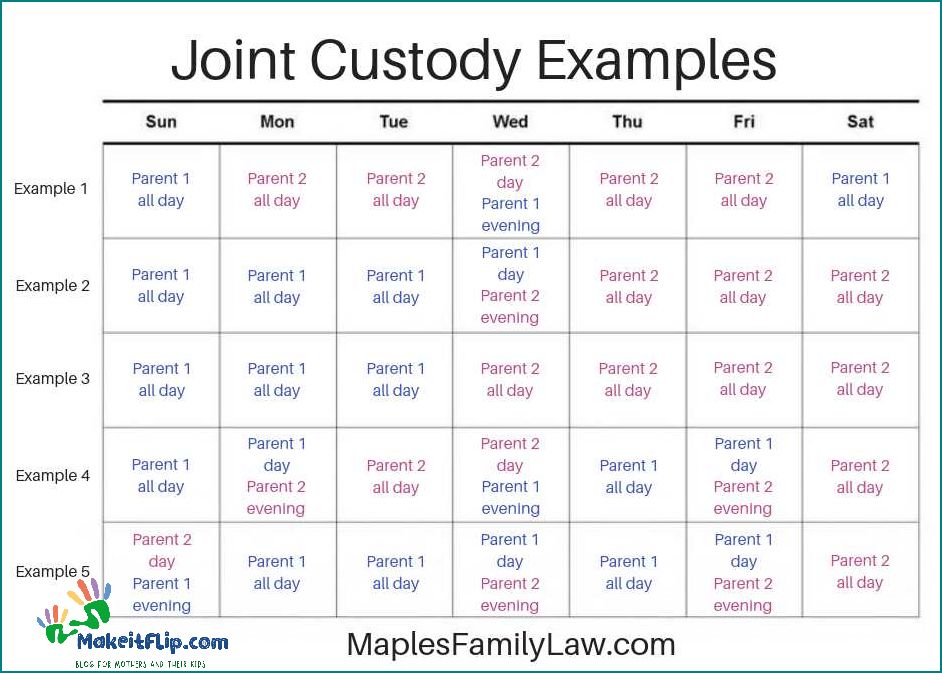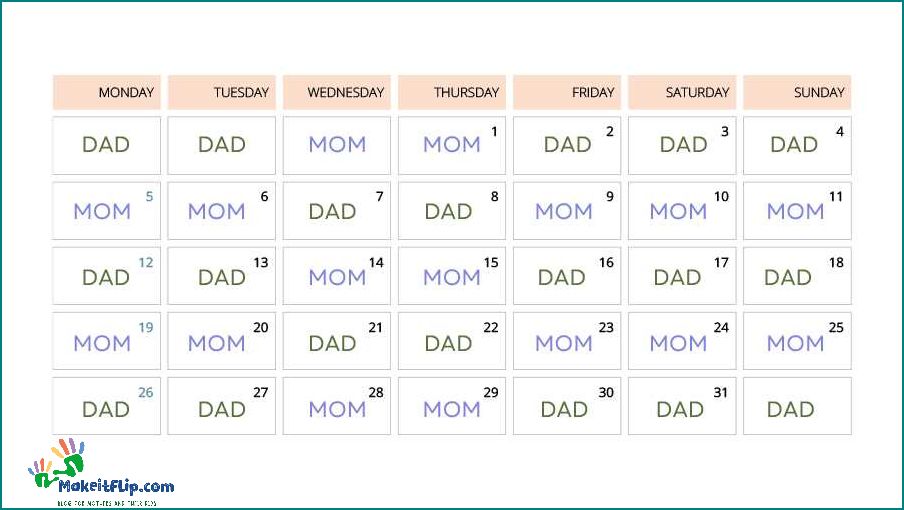Contents
- 1 A Comprehensive Guide for Co-Parenting: Understanding the 2-2-3 Custody Schedule
- 1.1 Understanding the 2 2 3 Custody Schedule
- 1.2 What is the 2 2 3 Custody Schedule?
- 1.3 Advantages of the 2 2 3 Custody Schedule
- 1.4 Considerations for Implementing the 2 2 3 Custody Schedule
- 1.5 Tips for Successful Co-Parenting with the 2 2 3 Custody Schedule
- 1.6 FAQ about topic 2 2 3 Custody Schedule A Comprehensive Guide for Co-Parenting
- 1.6.1 What is a 2-2-3 custody schedule?
- 1.6.2 What are the advantages of a 2-2-3 custody schedule?
- 1.6.3 How do I implement a 2-2-3 custody schedule?
- 1.6.4 What should I consider before choosing a 2-2-3 custody schedule?
- 1.6.5 Are there any potential challenges with a 2-2-3 custody schedule?
- 1.6.6 What is a 2-2-3 custody schedule?
- 1.6.7 How does a 2-2-3 custody schedule work?
- 1.6.8 What are the advantages of a 2-2-3 custody schedule?
- 1.6.9 Are there any disadvantages to a 2-2-3 custody schedule?
- 1.6.10 Is a 2-2-3 custody schedule right for every family?
A Comprehensive Guide for Co-Parenting: Understanding the 2-2-3 Custody Schedule

When it comes to co-parenting, creating a custody schedule that works for both parents and the child is crucial. One popular option is the 2-2-3 custody schedule. This schedule provides a balanced arrangement where the child spends two days with one parent, two days with the other parent, and then three days with the first parent.
With the 2-2-3 custody schedule, both parents have equal time with the child, allowing them to maintain a strong and consistent presence in their child’s life. This schedule also provides regular and frequent transitions between households, which can help the child adjust to the new routine and minimize any disruptions.
Coordinating a 2-2-3 custody schedule requires effective communication and cooperation between parents. It’s important to establish clear guidelines and expectations to ensure a smooth transition for the child. This may involve setting specific drop-off and pick-up times, as well as outlining any necessary arrangements for school, extracurricular activities, and holidays.
In this comprehensive guide, we will explore the benefits and challenges of a 2-2-3 custody schedule, provide tips for successful co-parenting, and offer strategies to navigate potential conflicts that may arise. Whether you are considering implementing a 2-2-3 custody schedule or looking for ways to improve your current co-parenting arrangement, this guide will provide valuable insights and support.
Understanding the 2 2 3 Custody Schedule
When it comes to co-parenting and sharing custody of your child, it’s important to have a clear and comprehensive schedule in place. One popular option is the 2 2 3 custody schedule, which provides a structured routine for both parents and the child.
What is the 2 2 3 Custody Schedule?
The 2 2 3 custody schedule is a type of shared custody arrangement where the child spends two days with one parent, two days with the other parent, and then three days with the first parent. This pattern then repeats, creating a consistent routine for the child.
For example, let’s say that Parent A has custody of the child on Mondays and Tuesdays, Parent B has custody on Wednesdays and Thursdays, and then the child spends Fridays, Saturdays, and Sundays with Parent A. The following week, the schedule flips, and the child spends Mondays and Tuesdays with Parent B, Wednesdays and Thursdays with Parent A, and Fridays, Saturdays, and Sundays with Parent B.
Benefits of the 2 2 3 Custody Schedule
The 2 2 3 custody schedule offers several benefits for both parents and the child. Firstly, it allows for frequent and consistent contact with both parents, which can help maintain strong relationships. Additionally, the schedule provides a sense of stability and routine for the child, as they know exactly when they will be with each parent.
Furthermore, the 2 2 3 custody schedule can be flexible and adaptable to different situations. It can be adjusted to accommodate holidays, special events, and other circumstances, making it a versatile option for co-parenting.
However, it’s important to note that the 2 2 3 custody schedule may not be suitable for all families. Every situation is unique, and it’s crucial to consider the child’s needs and the parents’ availability when determining the best custody schedule.
In conclusion, the 2 2 3 custody schedule is a popular choice for co-parenting families due to its structured routine and frequent contact with both parents. By understanding this schedule and its benefits, parents can create a positive and stable environment for their child.
What is the 2 2 3 Custody Schedule?
The 2 2 3 custody schedule is a type of custody arrangement that is commonly used by co-parents. It is a rotating schedule that allows both parents to have equal time with their child. The schedule is named after the pattern of days that each parent has custody.
Under the 2 2 3 custody schedule, one parent has custody of the child for two days, the other parent has custody for two days, and then the first parent has custody for three days. This pattern then repeats, alternating between the two parents.
This type of custody schedule is often chosen because it allows for frequent transitions between the parents’ homes, which can be beneficial for the child’s sense of stability and continuity. It also allows both parents to have regular and consistent time with their child.
However, the 2 2 3 custody schedule may not be suitable for all families. It requires a high level of cooperation and communication between the parents, as well as flexibility in scheduling. It may also be more challenging for the child to adjust to the frequent transitions between homes.
Overall, the 2 2 3 custody schedule can be an effective way for co-parents to share custody of their child and maintain a consistent and balanced parenting schedule.
Advantages of the 2 2 3 Custody Schedule

The 2 2 3 custody schedule has several advantages for co-parenting families. This type of custody arrangement allows for a consistent routine and frequent contact with both parents, which can be beneficial for the child’s well-being and development.
One advantage of the 2 2 3 custody schedule is that it provides equal time with both parents. This can help to ensure that the child maintains a strong relationship with both parents and feels loved and supported by both. It also allows both parents to be actively involved in the child’s day-to-day life, including school activities, extracurriculars, and other important events.
Another advantage of the 2 2 3 custody schedule is that it can be more flexible than other custody arrangements. With this schedule, the child spends two weekdays with one parent, two weekdays with the other parent, and then three consecutive days with the first parent. This rotation allows for flexibility in scheduling and can accommodate changes in work schedules, holidays, and other commitments.
The 2 2 3 custody schedule can also help to minimize conflict between co-parents. Since the schedule is consistent and predictable, there is less room for disagreements or misunderstandings about when the child will be with each parent. This can reduce stress and tension between co-parents and create a more peaceful co-parenting environment.
Additionally, the 2 2 3 custody schedule can be easier for the child to adjust to. The consistent routine and frequent transitions between parents’ homes can help the child feel more secure and stable. It can also allow the child to maintain relationships with siblings, extended family members, and friends on both sides of the family.
| Advantages of the 2 2 3 Custody Schedule |
|---|
| Equal time with both parents |
| Flexibility in scheduling |
| Minimizes conflict between co-parents |
| Easier for the child to adjust to |
Considerations for Implementing the 2 2 3 Custody Schedule

When it comes to co-parenting, finding a custody schedule that works for both parents and the children involved is crucial. One popular option is the 2 2 3 custody schedule, which provides a balanced arrangement for both parents to spend quality time with their children.
Flexibility is Key
Implementing the 2 2 3 custody schedule requires flexibility from both parents. This schedule involves alternating custody every two days, allowing each parent to have consecutive days with the children. It is important to be open to adjusting the schedule when necessary, as unexpected events or changes in circumstances may arise.
Communication is Essential
Effective communication between co-parents is vital when implementing the 2 2 3 custody schedule. Both parents should be able to discuss and agree upon any changes or adjustments to the schedule. This ensures that everyone is on the same page and that the children’s best interests are always prioritized.
Additionally, maintaining open lines of communication allows for a smoother transition between households. Parents can share important information about the children’s routines, school activities, and any other relevant updates to ensure consistency and stability in their lives.
Overall, implementing the 2 2 3 custody schedule requires cooperation, flexibility, and effective communication between co-parents. By considering these factors, both parents can create a nurturing and stable environment for their children, promoting their well-being and happiness.
Tips for Successful Co-Parenting with the 2 2 3 Custody Schedule
Co-parenting can be challenging, especially when you have a 2 2 3 custody schedule. This type of custody arrangement can be confusing and stressful for both parents and children. However, with some tips and strategies, you can make co-parenting with the 2 2 3 custody schedule successful and harmonious.
1. Communication is Key
Effective communication is crucial when co-parenting with the 2 2 3 custody schedule. Make sure to keep each other informed about any changes in schedules, school events, or important milestones in your child’s life. Use a shared calendar or a co-parenting app to stay organized and on the same page.
2. Be Flexible

Flexibility is essential when dealing with the 2 2 3 custody schedule. Unexpected things can come up, and it’s important to be willing to accommodate changes when necessary. Remember that the focus should always be on what’s best for your child, even if it means adjusting the schedule occasionally.
3. Create Consistency

While the 2 2 3 custody schedule can be unpredictable, try to establish consistency in your child’s routine. This includes bedtime, mealtimes, and rules at each parent’s house. Consistency provides stability and helps your child feel secure in both households.
4. Keep Conflict Away from the Children
Co-parenting can sometimes involve disagreements and conflicts. However, it’s crucial to keep these issues away from your children. Avoid arguing or speaking negatively about the other parent in front of your child. Instead, find a private and respectful way to resolve conflicts.
5. Focus on Quality Time
Make the most of the time you have with your child during the 2 2 3 custody schedule. Plan activities that you both enjoy and create lasting memories together. Quality time is essential for building a strong bond with your child and making them feel loved and supported.
By following these tips, you can navigate the challenges of co-parenting with the 2 2 3 custody schedule successfully. Remember to prioritize your child’s well-being and work together with the other parent to create a positive and nurturing environment for them.
FAQ about topic 2 2 3 Custody Schedule A Comprehensive Guide for Co-Parenting
What is a 2-2-3 custody schedule?
A 2-2-3 custody schedule is a type of co-parenting arrangement where the child spends two days with one parent, two days with the other parent, and then three days with the first parent. This schedule allows for equal time with both parents and can be beneficial for children who thrive on consistency and frequent transitions.
What are the advantages of a 2-2-3 custody schedule?
There are several advantages to a 2-2-3 custody schedule. Firstly, it allows for equal time with both parents, which can help maintain a strong bond with each parent. Secondly, the frequent transitions can provide stability and consistency for the child, as they get to see both parents regularly. Lastly, this schedule can be flexible and easily adjusted to accommodate holidays, vacations, and other special events.
How do I implement a 2-2-3 custody schedule?
Implementing a 2-2-3 custody schedule requires open communication and cooperation between both parents. It’s important to create a detailed parenting plan that outlines the schedule, including pick-up and drop-off times, as well as any specific rules or guidelines. Both parents should be willing to be flexible and make adjustments when necessary to ensure the schedule works for everyone involved.
What should I consider before choosing a 2-2-3 custody schedule?
Before choosing a 2-2-3 custody schedule, it’s important to consider the child’s age, temperament, and ability to handle frequent transitions. Some children may thrive on the consistency and regular contact with both parents, while others may find it overwhelming. It’s also important to consider the parents’ work schedules and any other commitments that could impact the feasibility of this schedule.
Are there any potential challenges with a 2-2-3 custody schedule?
While a 2-2-3 custody schedule can be beneficial for many families, there are potential challenges to consider. The frequent transitions can be tiring for both the child and the parents, and it may require a high level of coordination and communication between the co-parents. Additionally, if one parent lives far away or has an unpredictable work schedule, it may be difficult to maintain this type of schedule.
What is a 2-2-3 custody schedule?
A 2-2-3 custody schedule is a type of co-parenting arrangement where the child spends two days with one parent, two days with the other parent, and then three days with the first parent. This cycle then repeats.
How does a 2-2-3 custody schedule work?
In a 2-2-3 custody schedule, the child spends two days with one parent, two days with the other parent, and then three days with the first parent. This allows both parents to have equal time with the child and can be a good option for parents who live close to each other.
What are the advantages of a 2-2-3 custody schedule?
One advantage of a 2-2-3 custody schedule is that it allows both parents to have equal time with the child. This can help maintain a strong bond between the child and both parents. Additionally, it can be a good option for parents who live close to each other and want to minimize the amount of time the child spends traveling between homes.
Are there any disadvantages to a 2-2-3 custody schedule?
One potential disadvantage of a 2-2-3 custody schedule is that it can be more difficult to establish a consistent routine for the child. With the frequent transitions between homes, it may be harder for the child to adjust and feel settled. Additionally, it may require more coordination and communication between the parents to ensure a smooth transition for the child.
Is a 2-2-3 custody schedule right for every family?
A 2-2-3 custody schedule may not be the best fit for every family. It works best when both parents live close to each other and are able to effectively communicate and cooperate. Additionally, it may not be suitable for children who have difficulty adjusting to frequent changes in routine. It’s important for parents to consider their individual circumstances and the needs of their child when deciding on a custody schedule.
I’m Diana Ricciardi, the author behind Makeitflip.com. My blog is a dedicated space for mothers and their kids, where I share valuable insights, tips, and information to make parenting a bit easier and more enjoyable.
From finding the best booster seat high chair for your child, understanding the connection between sciatica and hip pain, to exploring the benefits of pooping in relieving acid reflux, I cover a range of topics that are essential for every parent.
My goal is to provide you with practical advice and solutions that you can easily incorporate into your daily life, ensuring that you and your child have the best possible experience during these precious years.
